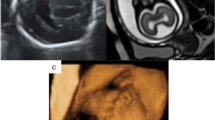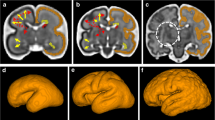Abstract
Methods
From the generally accepted data on the morphogenesis of the brain, the principles for the classification of brain malformations are given, and the salient features of each malformation which may be considered as independent from the developmental stage and therefore practical for MR imaging in the fetus after mid-gestation, are discussed.
Results and discussion
However, the correlation with the clinical results in 150 cases of malformations out of a series of more than 1,000 cases of MR fetal brain imaging, demonstrates that beside the main, well-defined malformative entities, a significant degree of uncertainty remains. As the indication of further imaging is mainly based on the ultrasonographic findings, cases that are not identified as abnormal by US are not submitted to MRI (partial commissural agenesis and malformations of cortical development). A striking discrepancy exists between the findings of US and those of MRI, in the specific instance of the disorders of the posterior fossa (cystic malformations versus mega cisterna magna versus cerebellar defects), which may be only partly corrected by the use of strict anatomic criteria. Similar difficulties are observed for the diagnosis of nondestructive microcephaly.
Conclusion
Long-term prospective longitudinal clinical-radiological studies of these groups of patients are needed.















Similar content being viewed by others
References
Altman NR, Naidich TP, Braffman BH (1992) Posterior fossa malformations. Am J Neuroradiol 13:691–724
Barkovich AJ (2000) Pediatric neuroimaging. Lippincott Williams and Wilkins, Philadelphia
Barkovich AJ, Kjos BO, Norman D, Edwards MS (1989) Revised classification of posterior fossa cysts and cystlike malformations based on the results of multiplanar MR imaging. Am J Neuroradiol 10:977–988
Barkovich AJ, Kuzniecky RI, Jackson GD, Guerrini R, Dobyns WB (2001) Classification system for malformations of cortical development. Update 2001. Neurology 57:2168–2178
Barkovich AJ, Simon EM, Walsh CA (2001) Callosal agenesis with cysts. A better understanding and new classification. Neurology 56:220–227
Blake JA (1900) The roof and lateral recesses of the fourth ventricle, considered morphologically and embryologically. J Comp Neurol 10:79–108
Copp AJ, Harding BN (1999) Neuronal migration disorders in humans and in mouse models—an overview. Epilepsy Res 36:133–141
Couly GF, Le Douarin NM (1987) Mapping of the early neural primordium in quail-chick chimera. II. The prosencephalic neural plate and neural folds: implications for the genesis of cephalic human congenital abnormalities. Dev Biol 120:206–214
De Morsier G (1956) Agénésie du septum lucidum avec malformation du tractus optique. La dysplasie septo-optique. Schweiz Arch Neurol Psychiat 77:267–292
Fees-Higgins A, Larroche JC (1987) Development of the human fetal brain. An anatomical atlas. INSERM/Masson, Paris
Girard N, Raybaud C, Gambarelli D, Figarella-Brangier D (2001) Fetal brain MR imaging. Magn Reson Imaging Clin N Am 9:19–56
Liliequist B (1959) The subarachnoid cisterns. An anatomic and roentgenologic study. Acta Radiol Suppl 185
McLone D, Knepper PA (1989) The cause of Chiari II malformation: a unified theory. Pediatr Neurosci 15:1–12
Mischel PS, Nguyen LP, Vinters HV (1995) Cerebral cortical dysplasia associated with pediatric epilepsy. Review of neuropathologic features and proposal for a grading system. J Neuropathol Exp Neurol 54:137–153
Norman MG, McGillivray BC, Kalousek DK, Hill A, Poskitt KJ (1995) Congenital malformations of the brain. Pathological, embryological, clinical, radiological and genetic aspects. Oxford University Press, New York
Osaka H, Handa H, Matsumoto S, Yasuda M (1980) Development of the cerebrospinal fluid pathway in the normal and abnormal human embryos. Childs Brain 6:26–38
Patel S, Barkovich AJ (2002) Analysis and classification of cerebellar malformations. Am J Neuroradiol 23:1074–1087
Raybaud C (1982) Cystic malformations of the posterior fossa. Abnormalities associated with the development of the roof of the fourth ventricle and adjacent meningeal structures. J Neuroradiol 9:103–133
Raybaud C, Girard N (1998) Etude anatomique par IRM des agénésies et dysplasies commissurales télencéphaliques. Neurochirurgie (Paris) 44 [Suppl 1]:38–60
Raybaud C, Girard N (1999) The developmental disorders of the commissural plate of the telencephalon. MR imaging study and morphologic classification. Nerv Syst Child 24:348–355
Raybaud C, Girard N (1999) The malformations of the posterior fossa. Nerv Syst Child 24:323–331
Raybaud C, Girard N, Canto-Moreira N, Poncet M (1996) High definition magnetic resonance imaging identification of cortical dysplasias: micropolygyria versus lissencephaly. In: Guerrini R, Canapicchi R, Zifkin BC, Anderman F, Roger J, Pfanner P (eds) Dysplasia of cerebral cortex and epilepsy. Lippincott-Raven, Philadelphia, pp 131–143
Raybaud C, Girard N, Levrier O, Peretti-Viton P, Manera L, Farnarier P (2001) Schizencephaly: correlation between the lobar topography of the cleft(s) and absence of the septum pellucidum. Childs Nerv Syst 17:217–222
Raybaud CA, Strother CM, Hald JK (1989) Aneurysms of the vein of Galen: embryonic considerations and anatomical features relating to the pathogenesis of the malformation. Neuroradiology 31:109–128
Sidman RL, Rakic P (1973) Neuronal migration with special reference to developing human brain: a review. Brain Res 62:1–35
Tortori-Donati P, Fondelli M, Rossi A, Carini S (1996) Cystic malformations of the posterior cranial fossa originating from a defect of the posterior membranous area: mega cisterna magna and persisting Blake's pouch: two separate entities. Childs Nerv Syst 12:303–308
Yakovlev PI, Wadsworth RC (1946) Schizencephalies. A study of the congenital clefts in the cerebral mantle. I. Clefts with fused lips. J Neuropathol Exp Neurol 5:116–130
Yakovlev PI, Wadsworth RC (1946) Schizencephalies. A study of the congenital clefts in the cerebral mantle. II. Clefts with hydrocephalus and lips separated. J Neuropathol Exp Neurol 5:169–206
Author information
Authors and Affiliations
Corresponding author
Rights and permissions
About this article
Cite this article
Raybaud, C., Levrier, O., Brunel, H. et al. MR imaging of fetal brain malformations. Childs Nerv Syst 19, 455–470 (2003). https://doi.org/10.1007/s00381-003-0769-2
Received:
Published:
Issue Date:
DOI: https://doi.org/10.1007/s00381-003-0769-2




